基于语义分割和混沌杜鹃搜索算法的肝脏病变检测
IF 2
4区 计算机科学
Q3 AUTOMATION & CONTROL SYSTEMS
引用次数: 0
摘要
近年来肝癌计算机辅助诊断(CAD)研究中使用的经典特征提取技术存在特征重复、计算量大等缺点。现代深度学习方法通过隐式检测大量医疗图像数据中的复杂结构来解决这些问题。这项研究提出了一种独特的生物启发的深度学习方法来提高肝癌的预测结果。首先,提出了一种新的语义分割技术unet++,用于从计算机断层扫描(CT)图像中提取肝脏病变。其次,提出了一种结合混沌杜鹃搜索算法和AlexNet的混合方法作为肝脏病变的特征提取和分类器。LiTS是一个免费访问的数据库,包含腹部CT图像,用于肝脏肿瘤的诊断和调查。使用Dice相似系数和相关系数对分割结果进行评价。分类结果采用准确性、精密度、召回率、F1评分和特异性进行评估。在准确度、精密度和召回率等性能指标上,推荐方法的性能优于现有算法,分别达到99.2%、98.6%和98.8%的最高值。本文章由计算机程序翻译,如有差异,请以英文原文为准。
Liver Lesion Detection Using Semantic Segmentation and Chaotic Cuckoo Search Algorithm
The classic feature extraction techniques used in recent research on computer-aided diagnosis (CAD) of liver cancer have several disadvantages, including duplicated features and substantial computational expenses. Modern deep learning methods solve these issues by implicitly detecting complex structures in massive quantities of healthcare image data. This study suggests a unique bio-inspired deep-learning way for improving liver cancer prediction outcomes. Initially, a novel semantic segmentation technique known as UNet++ is proposed to extract liver lesions from computed tomography (CT) images. Second, a hybrid approach that combines the Chaotic Cuckoo Search algorithm and AlexNet is indicated as a feature extractor and classifier for liver lesions. LiTS, a freely accessible database that contains abdominal CT images, was employed for liver tumor diagnosis and investigation. The segmentation results were evaluated using the Dice similarity coefficient and Correlation coefficient. The classification results were assessed using Accuracy, Precision, Recall, F1 Score, and Specificity. Concerning the performance metrics such as accuracy, precision, and recall, the recommended method performs better than existing algorithms producing the highest values such as 99.2%, 98.6%, and 98.8%, respectively.
求助全文
通过发布文献求助,成功后即可免费获取论文全文。
去求助
来源期刊

Information Technology and Control
工程技术-计算机:人工智能
CiteScore
2.70
自引率
9.10%
发文量
36
审稿时长
12 months
期刊介绍:
Periodical journal covers a wide field of computer science and control systems related problems including:
-Software and hardware engineering;
-Management systems engineering;
-Information systems and databases;
-Embedded systems;
-Physical systems modelling and application;
-Computer networks and cloud computing;
-Data visualization;
-Human-computer interface;
-Computer graphics, visual analytics, and multimedia systems.
 求助内容:
求助内容: 应助结果提醒方式:
应助结果提醒方式:


